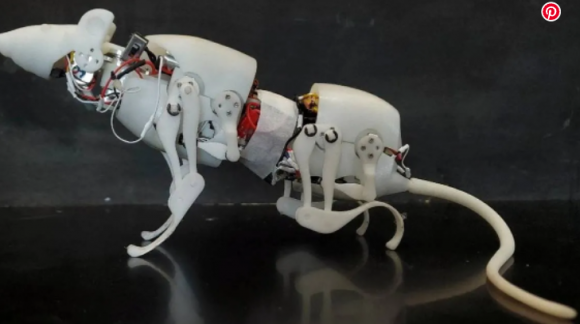The four-legged robot has been called SquRo and is capable of walking, standing, crawling and spinning just like its flesh-and-blood counterparts.
In recent years we have seen the manufacture of all kinds Robotic versions associated with animals: bees, various insects, fish, dogs … Now it is the turn of mice.
A team of scientists from Beijing Institute of Technology has unveiled this four-legged robot called SQuRo (small four-legged robotic mouse), A small mouse can bend, stand, walk, crawl and spin just like a real mouseIt can even carry a load equivalent to 91% of its weight.
According to the researchers, Mice have been a major inspiration for many developers when it comes to robotics. Let’s remember that they are experts at getting through tight spaces thanks to their long, thin bodies and amazing agility.
Cave rat study
In a prototype experiment, The robotic rat was able to overcome obstacles 30 mm high (ie 33% of its height) with a success rate of 70%. In a recent experiment, SQuRo was able to correct himself after falling on his side.
The robot has two degrees of freedom at each end, as well as in the waist and head, allowing its spine to move with the flexibility of a true rat.
“SQuRo can achieve stable motion even after carrying a load equivalent to 91% of its weight, demonstrating its superior load-carrying capacity compared to small, four-legged robots,” the researchers explained.
How tall is a robotic rat?
The robot is currently 19 cm long and weighs 220 grams; It is powered by a rechargeable solar battery that lasts 30 minutes and is remotely controlled via WiFi using a computer or phone.
“To our knowledge, SQuRo is the first small-sized four-legged robot of this scale capable of five movement patterns, including standing, walking, crawling, turning, and recovering from a fall,” professor and deputy director of the Beijing Institute of Technology’s Institute of Intelligent Robotics and study leader Published by IEEE Transactions on Robotics.
When will it be available?
According to experts, the robot rat can be commercialized from 2025. In the meantime, they will continue to improve the device, including increasing agility, installing more sensors for field testing in narrow, unstructured tubes, and making the machines airtight.
“Robots can be sent to earthquake rubble or collapsed buildings where the debris forms too narrow a space for rescuers to enter. They can provide emergency rations for people trapped under the rubble of a disaster.”
In general, the robot can handle all kinds of weather and terrain conditions, according to China’s state-run People’s Daily.
(With information from so interesting)

“Unapologetic tv specialist. Hardcore zombie trailblazer. Infuriatingly humble problem solver.”

:quality(85)/cloudfront-us-east-1.images.arcpublishing.com/infobae/UDDOK5CJV5CU5MITSI5TNVFIJM.jpg)
:quality(85)/cloudfront-us-east-1.images.arcpublishing.com/infobae/TRFQARYQ25CLHC3YC4ZCI65UFQ.jpg)

:quality(85)/cloudfront-us-east-1.images.arcpublishing.com/infobae/V6ZZZ4HWOVDYZLZBWADR5TFGK4.png)


More Stories
The protests rocking campuses across the United States are not only demanding an end to the war in Gaza;
ASEAN 2045: A path full of opportunities and challenges – Special Offers | Publications
Maduro receives leaders participating in the ALBA-TCP Summit